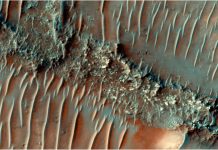
Imagine if little pieces of Mars fell on Earth. Cool, right? Well, they do!
These Martian rocks are quite rare and give us lots of information about Mars.
However, scientists were puzzled about how old these rocks are and where exactly they came from on Mars.
Thanks to a recent study in the Earth and Planetary Science Letters, some of this mystery is solved. Most Martian rocks on Earth are surprisingly young. They’re only a few hundred million years old and probably came from volcanic events on Mars, like eruptions from its biggest volcano, Olympus Mons.
Dr. Ben Cohen, a volcano expert from the University of Glasgow, has been trying to figure out the age of these Martian rocks. “We’re sure these rocks come from Mars,” says Ben.
“Big explosions on Mars sent these rocks into space, and they eventually landed on Earth. But Mars has so many craters that we didn’t know where these rocks were from. Knowing their age can give us a hint.”
Here’s where things got tricky: Of the 70,000 meteorites found on Earth, only about 358 are believed to be from Mars. Among these, the most common ones are called shergottites. The odd thing? Most of Mars’ surface is really, really old—between three to four billion years.
But these shergottites? They seemed to be much younger, only a few hundred million years old. This difference in ages was puzzling and was called the Shergottite Age Paradox.
Dr. Ben said, “Some thought big explosions on Mars were changing the way we measure rock ages, making them seem younger than they really are.” But when they looked at many meteorites in various ways, they consistently appeared young. This meant the puzzle wasn’t fully solved.
To understand the age of Martian rocks, scientists use various methods. One common method is called the “argon-argon” method, which measures how potassium changes to argon over time in rocks. This works great for Earth rocks, but rocks from Mars that have been floating in space? That’s a different story.
“There are more sources of argon in Martian rocks compared to Earth rocks,” says Ben. “This extra argon was confusing our measurements.”
So, Dr. Ben and his team decided to use modern tools to study the argon-argon method more closely. They even put tiny pieces of Martian rocks into a special nuclear reactor to measure the argon in them better. With this new method, they could tell how much argon came from space and how much from Mars or Earth.
After these corrections, the ages they got for the rocks matched with other methods, like Uranium-Lead. “Our findings are exciting because they give us a better understanding of Mars,” said Professor Caroline Smith from the Museum, who worked on the study.
She also mentioned how this research is helping us learn more about Mars using meteorites and Mars exploration missions.
So, why are most Martian rocks on Earth so young? The most likely reason is that Mars has a layer of loose rock on its surface called regolith. Over time, this layer got thicker due to constant bombardments.
New volcanic eruptions also kept bringing fresh, young rocks to the surface. When an explosion happened, it became harder for older rocks beneath this layer to get blasted into space.
“The thicker the loose rock layer, the less chance for the old rock beneath to fly off Mars,” Ben explains. “That’s why we find more ‘young’ Martian rocks on Earth than older ones.”
So, next time you hear about a Martian rock found on Earth, remember: It might be a young piece from a very old planet, and scientists have been playing detectives to uncover its story!
Follow us on Twitter for more articles about this topic.
Source: KSR.



